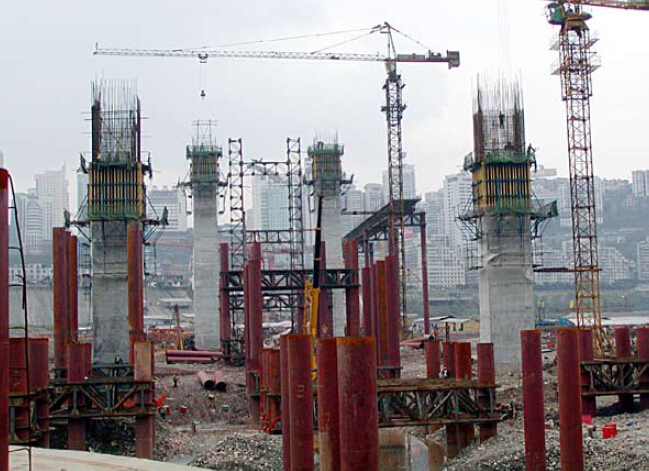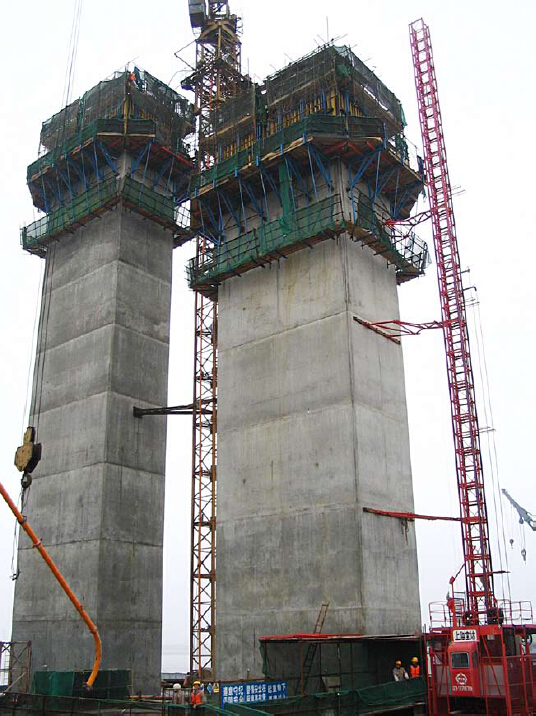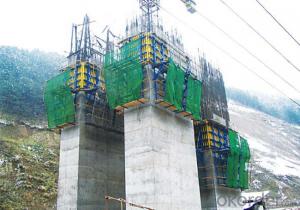Climbing Bracket CB-240 for formwork and scaffolding system
- Loading Port:
- Tianjin
- Payment Terms:
- TT OR LC
- Min Order Qty:
- 50 m²
- Supply Capability:
- 1000 m²/month
OKorder Service Pledge
OKorder Financial Service
You Might Also Like
Climbing Bracket CB240 & CB210
They are framework brackets for supporting large-area wall formwork.
Typical applications for the CB240&CB210 are pier and column/shear wall/core walll/ in the
building.
CB210 has smaller size than CB240, it will be cost effective in some condition.
Characteristics:
◆ High bearing capacity
The high loading capacity of the brackets allow very large scaffold units. This saves the number
anchor points required as well as reducing climbing times.
◆ Simple moving procedure by crane
Through the strong connection of formwork together with the climbing scaffold, both can be moved
as a single climbing unit by crane. Thus valuable time-savings can be achieved.
◆ Fast striking process without a crane
With the retrusive set, large formwork elements can also be retracted quickly and a minimum of
effort.
◆ Safe with work platform
The platforms have assembled firmly with bracket and will be climbing together, without scaffolding
but can work safely in spite of your high location.


- Q:What are the different types of finishes available for steel formwork panels?
- The different types of finishes available for steel formwork panels include galvanized, painted, and powder-coated finishes. Galvanized finishes provide corrosion resistance by applying a layer of zinc on the surface of the steel. Painted finishes add color and protection to the panels, while powder-coated finishes offer a durable and aesthetically pleasing coating that is resistant to chipping, scratching, and fading.
- Q:Can steel formwork be used for precast concrete arches?
- Precast concrete arches can indeed utilize steel formwork. This material, known for its versatility and durability, proves highly capable of constructing intricate shapes and structures, including arches. During the casting process, steel formwork offers exceptional support and stability, ensuring the precise and accurate formation of arches. Moreover, steel formwork easily adapts to various arch designs and dimensions, thanks to its customizable nature. Its strength and rigidity further enable it to withstand the pressure and weight of the concrete during the curing process. Consequently, steel formwork emerges as the preferred choice for constructing precast concrete arches due to its flexibility, strength, and reliability.
- Q:Is steel formwork suitable for projects with high concrete pressure?
- Yes, steel formwork is suitable for projects with high concrete pressure. Steel formwork is known for its strength and durability, making it capable of withstanding the pressure exerted by the wet concrete during the pouring and curing process. It can handle the weight and pressure of the concrete without deforming or collapsing, ensuring the stability and integrity of the structure being built. Steel formwork also provides a smooth and consistent surface finish to the concrete, which is essential for projects that require high-quality finishes. Additionally, steel formwork can be reused multiple times, making it a cost-effective option for projects with high concrete pressure.
- Q:Can steel formwork be easily disassembled and removed after construction?
- Certainly! After construction, it is possible to easily disassemble and remove steel formwork. These formwork systems are specifically designed to be reusable and offer great flexibility when it comes to assembly and disassembly. Typically, the components of steel formwork are lightweight, making them easily manageable and movable by construction workers. Furthermore, steel formwork systems often incorporate adjustable clamps and brackets, enabling swift and efficient dismantling. This not only saves time and labor costs but also permits the reuse of the formwork in future construction endeavors, making it an environmentally-friendly and cost-effective option for construction projects.
- Q:Can steel formwork be used for projects with aggressive concrete mixes?
- Projects with aggressive concrete mixes can indeed utilize steel formwork. The strength, durability, and resistance to various environmental factors are well-known qualities of steel formwork. Aggressive concrete mixes typically consist of higher concentrations of chemicals like chlorides, sulfates, or alkalis, which have the potential to corrode certain materials. Nevertheless, steel formwork typically proves resilient against these aggressive chemical attacks and endures the harsh conditions associated with such mixes. It is crucial to ensure that the steel formwork employed is adequately coated or treated to enhance its corrosion resistance and ability to withstand chemical attacks. Regular maintenance and inspection of the formwork are also essential to detect and address any signs of deterioration or damage. In summary, due to its strength and resistance to chemical attacks, steel formwork can indeed be a suitable option for projects with aggressive concrete mixes.
- Q:Can steel formwork be used for concrete structures in marine environments?
- Steel formwork can be used for concrete structures in marine environments, but it requires special considerations and precautions. Marine environments, with their high levels of saltwater exposure and corrosive elements, pose unique challenges for steel formwork. The corrosive nature of the seawater can cause rapid deterioration and rusting of the steel formwork, compromising its structural integrity. To mitigate these risks, it is necessary to use high-quality corrosion-resistant steel, such as stainless steel or galvanized steel, for the formwork. These materials have better resistance to corrosion and can withstand the harsh marine environment for a longer period. Additionally, proper maintenance and regular inspection are essential to identify any signs of corrosion or damage and address them promptly. This may involve cleaning the formwork regularly, removing any accumulated salt or debris, and applying protective coatings to prevent corrosion. Furthermore, it is important to consider the design of the formwork to ensure proper drainage and minimize water exposure. Adequate provision for drainage channels and weep holes should be included to avoid the accumulation of water, which can accelerate corrosion. In conclusion, while steel formwork can be used in marine environments, it requires careful selection of corrosion-resistant materials, regular maintenance, and proper design considerations to ensure its durability and longevity. It is recommended to consult with experienced professionals and engineers who have expertise in marine construction to ensure the success of concrete structures in such environments.
- Q:Are there any special considerations when using steel formwork in cold weather conditions?
- Special considerations should be taken into account when using steel formwork in cold weather conditions. Firstly, the cold temperatures can cause steel to contract and become more brittle, increasing the risk of cracks or fractures in the formwork. Therefore, it is important to ensure that the steel formwork is properly designed and reinforced to withstand the potential stress caused by temperature changes. Secondly, the curing process of concrete can be affected by the cold weather. Steel formwork tends to conduct heat away from the concrete, slowing down the curing process. This can result in insufficient strength development and compromise the structural integrity. To address this, additional measures may be necessary, such as using insulating materials or applying external heat sources to maintain optimal curing conditions. Furthermore, cold weather can lead to the formation of ice on the surface of the steel formwork due to moisture freezing. This can increase the weight of the formwork and make its removal difficult. Additionally, it can cause damage if not properly managed. Therefore, preventive measures must be taken, such as using anti-freeze agents or ensuring adequate drainage to prevent ice buildup. Lastly, working in cold weather conditions can pose challenges for construction workers. It is crucial to implement appropriate safety measures, including providing sufficient insulation, heating facilities, and protective clothing to prevent workers from experiencing hypothermia or other cold-related illnesses. In conclusion, when working with steel formwork in cold weather conditions, it is important to consider the increased risk of brittleness, the impact on concrete curing, the potential for ice formation, and the well-being of workers. By taking these special considerations into account, the use of steel formwork can still be efficient and effective in cold weather conditions.
- Q:Are there any safety considerations when using steel formwork?
- Yes, there are several safety considerations when using steel formwork in construction projects. Firstly, handling and installing steel formwork panels can be physically demanding due to their weight and size. It is necessary to have proper lifting equipment and trained personnel to safely handle and position the formwork panels to prevent accidents or injuries. Secondly, steel formwork should be securely supported and braced to ensure stability during concrete pouring. Proper anchoring and shoring systems should be in place to prevent collapse or displacement of the formwork, which can lead to serious accidents. Additionally, working at heights while installing or removing steel formwork can pose a risk of falls. It is important to provide suitable fall protection measures such as guardrails, safety nets, or personal fall arrest systems to prevent workers from falling from elevated surfaces. Furthermore, steel formwork may have sharp edges or protruding parts that can cause lacerations or puncture wounds. Workers should be provided with appropriate personal protective equipment (PPE) such as gloves, safety boots, and eye protection to minimize the risk of injury. Moreover, steel formwork should be regularly inspected for any signs of damage or deterioration. Any damaged or weakened components should be replaced promptly to maintain the structural integrity and safety of the formwork system. Lastly, proper communication and coordination among workers is essential to prevent accidents. Clear instructions, training, and supervision are necessary to ensure that all workers understand and follow the safety procedures when using steel formwork. Overall, by adhering to these safety considerations and implementing appropriate safety measures, the risks associated with using steel formwork can be minimized, creating a safer working environment for construction personnel.
- Q:Is steel formwork suitable for projects with high architectural demands?
- Yes, steel formwork is suitable for projects with high architectural demands. Steel formwork offers several advantages that make it suitable for such projects. Firstly, steel formwork is highly durable and can withstand the pressures and forces exerted during the construction process. This ensures that the formwork maintains its shape and integrity, resulting in precise and accurate concrete structures. Additionally, steel formwork is versatile and can be customized to meet specific architectural requirements. It can be easily fabricated into intricate shapes and designs, allowing for the creation of unique and visually appealing structures. This makes it ideal for projects that demand complex architectural elements. Furthermore, steel formwork provides a high-quality finish to concrete surfaces. It creates smooth and uniform surfaces, reducing the need for additional finishing work. This is especially important for projects with high architectural demands, where attention to detail and aesthetic appeal are crucial. Moreover, steel formwork offers excellent strength and stability, ensuring that the concrete structures maintain their shape and remain intact over time. This is particularly important for projects with high architectural demands, where structural integrity is paramount. Overall, steel formwork is a suitable choice for projects with high architectural demands due to its durability, versatility, high-quality finish, and strength. It allows for the creation of complex and visually appealing structures while ensuring structural integrity and long-term performance.
- Q:How does steel formwork perform in fire-resistant structures?
- Fire-resistant structures benefit greatly from the exceptional performance of steel formwork. Steel possesses inherent properties, including a high melting point and strength, which make it an ideal material for withstanding high temperatures and maintaining structural integrity in the event of a fire. To begin with, steel formwork exhibits non-combustible characteristics, meaning it does not contribute to the spread or intensity of a fire. Unlike certain construction materials, it does not burn or release harmful gases when exposed to flames. This quality aids in preventing the rapid propagation of fire within the structure, affording valuable time for evacuation and fire suppression efforts. Furthermore, steel possesses a high melting point in comparison to other commonly used formwork materials such as wood or plastic. This attribute enables steel formwork to retain its structural integrity even when subjected to intense heat. It can endure temperatures well above 1000°C (1832°F) without significant deformation or collapse, ensuring the stability of the structure and minimizing the risk of sudden structural failure during a fire. Moreover, steel formwork exhibits excellent load-bearing capabilities, even under high temperatures. This characteristic is crucial in fire-resistant structures as it allows the building to maintain its structural capacity when exposed to fire. The ability of steel formwork to bear the weight of the structure, even when compromised by fire, helps prevent structural collapse and ensures the safety of occupants and emergency personnel. Additionally, steel formwork is known for its durability and longevity, which are essential qualities in fire-resistant structures. It can withstand the effects of fire, such as thermal expansion and contraction, without sustaining significant damage. This durability ensures that the formwork can be reused or remain in place for future fire events, providing ongoing fire protection for the structure. In conclusion, steel formwork demonstrates exceptional performance in fire-resistant structures. Its non-combustible nature, high melting point, load-bearing capabilities, and durability make it a reliable choice for maintaining the structural integrity and safety of the building in the event of a fire.
1. Manufacturer Overview |
|
|---|---|
| Location | |
| Year Established | |
| Annual Output Value | |
| Main Markets | |
| Company Certifications | |
2. Manufacturer Certificates |
|
|---|---|
| a) Certification Name | |
| Range | |
| Reference | |
| Validity Period | |
3. Manufacturer Capability |
|
|---|---|
| a)Trade Capacity | |
| Nearest Port | |
| Export Percentage | |
| No.of Employees in Trade Department | |
| Language Spoken: | |
| b)Factory Information | |
| Factory Size: | |
| No. of Production Lines | |
| Contract Manufacturing | |
| Product Price Range | |
Send your message to us
Climbing Bracket CB-240 for formwork and scaffolding system
- Loading Port:
- Tianjin
- Payment Terms:
- TT OR LC
- Min Order Qty:
- 50 m²
- Supply Capability:
- 1000 m²/month
OKorder Service Pledge
OKorder Financial Service
Similar products
New products
Hot products
























